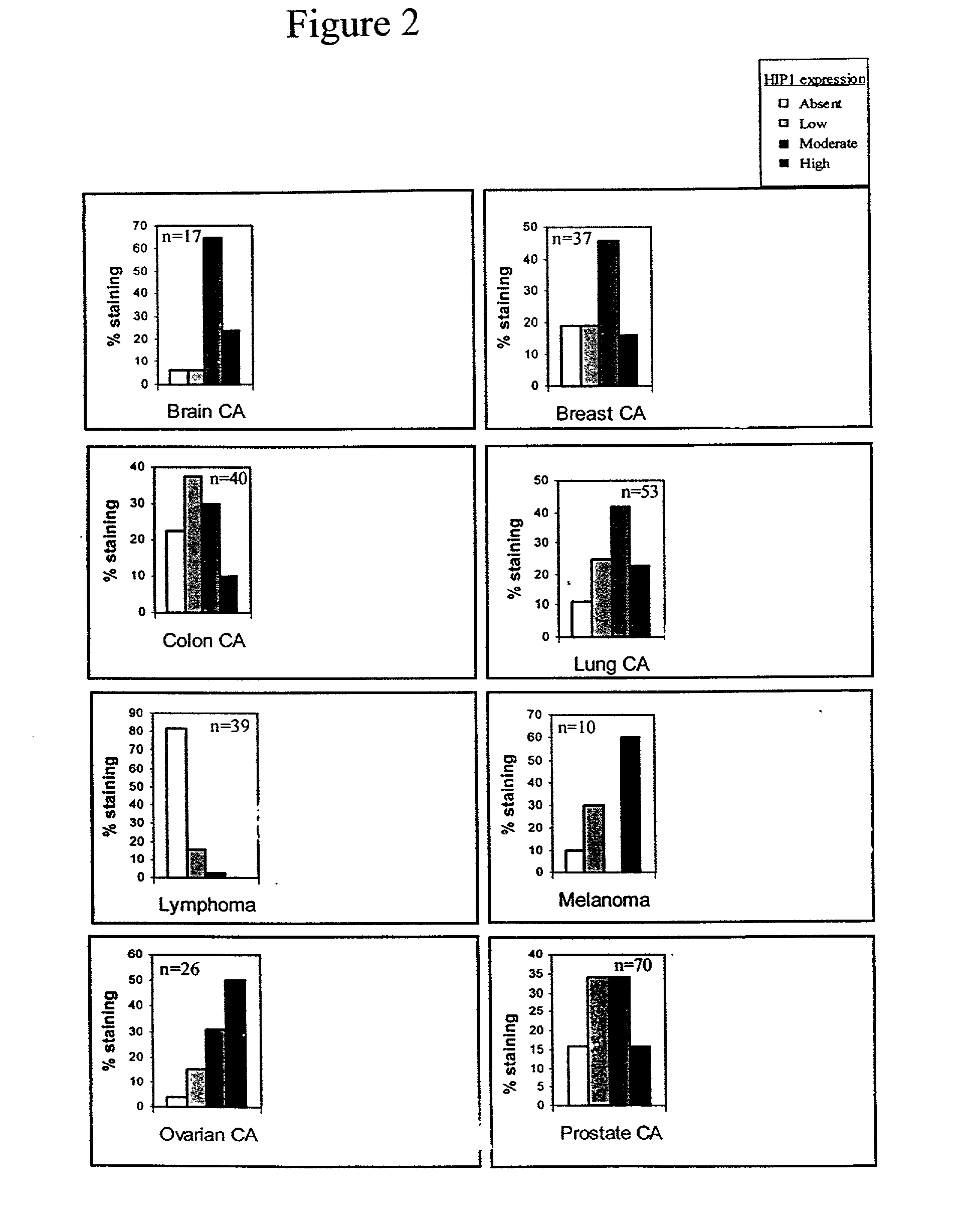HIP1 cancer markers
- Summary
- Abstract
- Description
- Claims
- Application Information
AI Technical Summary
Benefits of technology
Problems solved by technology
Method used
Image
Examples
example 1
HIP1 Expression in Cancerous and Non-Cancerous Tissues
[0263] A. Monoclonal Antibodies
[0264] The antibodies to HIP1 were generated by isolating a human HIP1 cDNA and creating a bacterial expression vector containing the sequences encoding the carboxyl half of the HIP1 protein. The expressed and purified recombinant protein was use to immunize mice and create monoclonal antibodies by standard methods. The specificity of the antibodies to HIP1 was confirmed by comparing Western blot analyses of murine embryonic fibroblast extracts derived from embryos with HIP1 deleted and their wild type litter mates (data not shown). Three monoclonal antibodies were found to be useful for Western blot analysis of HIP1, as well as for IHC of human tissue. These antibodies were designated HIP1-4B10, HIP1-1A1 and HIP1-1B11. Antibodies 4B10 and 1A1 recognize only human HIP1. Antibody 1B11 recognizes both human and mouse HIP1. The hybridomas producing antibodies HIP1-4B10, 1A1 and HIP1-1B11 were deposited...
example 2
HIP1 Expression in a Mouse Model of Prostate Cancer
[0288] This example describes an investigation of the expression of HIP1 in a transgeric mouse model of prostate cancer, designated the TRAMP mouse (Greenberg et al., PNAS 92:3439 [1995]). The TRAMP mouse was created by use of a transgene where the rat probasin promoter drives expression of SV40 early genes (T and t; Tag). SV40 Tag interacts with p53 and the retinoblasoma gene product Rb abrogating their tumor suppressor gene functions.
[0289] HIP1 was found to be overexpressed in 50% of prostate tumors from TRAMP mice (n=10) compared to the normal prostate (FIG. 6a), suggesting that its expression is an active component of tumorigenesis in these mice. The heterogeneity of HIP1 expression is similar to that seen in human prostate cancers.
example 3
HIP1 ENTH Mutant
[0290] The effect of expression of a HIP1 dominant negative mutant on cellular survival was next investigated. At the molecular level, the dominant negative mutant of HIP1 (HIP1 / deltaE lacking the ENTH domain) promoted cell death but expression of wild type HIP1 (FLHIP1) or vector alone (pcDNA3) did not induce cell death (FIG. 6b). 39% of HIP1 / DE-expressing cells and 50% of caspase 9-expressing cells were apoptotic. FIG. 12 shows the correction of HIP1 deltaE apoptosis by the expression fall length HIP1 (FLPHIP1). FIG. 13 shows the correction of apoptosis by the expression of dominant negative caspase 9 (DN Casp 9) and constitutatively active Akt (Myr-AKT) but not dominant negative caspase 8 (DN I-FLICE) or activated ras (Ras-V12). Expression of the endogenous HIP1, wild type HIP1, HIP1 / DE and Caspase 9 was documented by Western blot analysis as shown in the bottom of FIG. 6b.
PUM
| Property | Measurement | Unit |
|---|---|---|
| Composition | aaaaa | aaaaa |
| Cell death | aaaaa | aaaaa |
| Biological properties | aaaaa | aaaaa |
Abstract
Description
Claims
Application Information
 Login to View More
Login to View More - R&D
- Intellectual Property
- Life Sciences
- Materials
- Tech Scout
- Unparalleled Data Quality
- Higher Quality Content
- 60% Fewer Hallucinations
Browse by: Latest US Patents, China's latest patents, Technical Efficacy Thesaurus, Application Domain, Technology Topic, Popular Technical Reports.
© 2025 PatSnap. All rights reserved.Legal|Privacy policy|Modern Slavery Act Transparency Statement|Sitemap|About US| Contact US: help@patsnap.com



